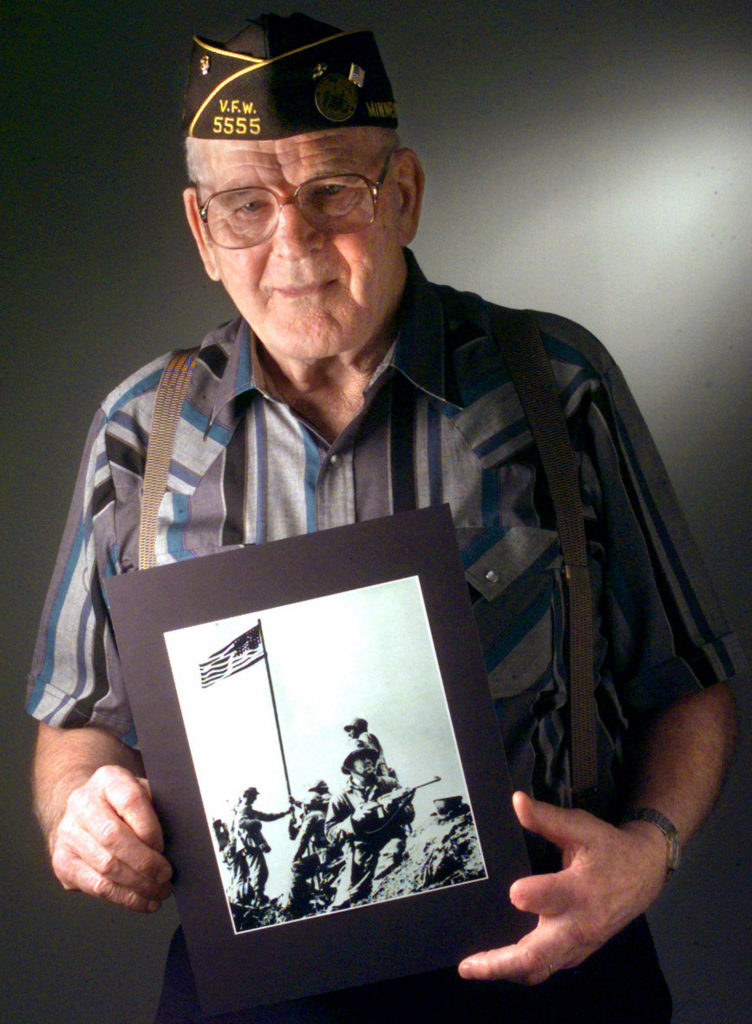
The First Iwo Jima Flag Raising
Note: In the 1990's I had the opportunity to correspond with Charles Lindberg and received the following photos, leaflet and newspaper article directly from Mr. Lindberg.
The captions shown were taped to the back of each 8" x 10" photograph.
Corporal Charles W. Lindberg, then 24, in 1945 carried a flame thrower with Company E, 28th Marines. He took part in raising the first flag atop Iwo Jima's Mount Suribachi and earned a Silver Star Medal for bravery. He is standing at the right in the above photo.
Out of the 40 man platoon that made the climb up Suribachi and raised the first American flag on captured Japanese territory, 36 were killed or wounded in the subsequent fighting on Iwo Jima.
A 24-year-old corporal who was a combat veteran of the Guadalcanal and Bougainville campaigns, Lindberg watched the intense bombardment of Iwo Jima but realized that the landing at Red Beach One would be anything but easy. "The Japs had the whole beach zeroed in. Most of the fire was coming from Suribachi," he recalled. "Suribachi was easy to take; it was getting there that was so hard."
Surrounding Mount Suribachi were cliffs, tunnels, mines, booby traps and ravines. The hostile terrain proved to be as tough an enemy as the Japanese who were firmly entrenched on the mountain.
Corporal Lindberg carried a flame thrower with Company E, 28th Marines, 5th Marine Division on Iwo Jima from 13 February to 1 March 1941. As a member of the first combat patrol to scale Mount Suribachi, he took his flame thrower up the steep slopes and assisted in destroying the occupants of the many caves found in the rim of the volcano.
In the photo immediately above, the Iwo flag raising made famous by the Joseph Rosenthal photo is in the background. The original flag (foreground) is being taken down as the second flag is raised. Corporal Lindberg is assisting.
For his heroism he received the Silver Star, and his citation reads in part:
"Repeatedly exposing himself to hostile grenades and machine gun fire in order that he might reach and neutralize enemy pillboxes at the base of Mount Suribachi, Corporal Lindberg courageously approached within ten or fifteen yards of the emplacements before discharging his weapon, thereby assuring the annihilation of the enemy and the successful completion of his platoon's mission. While engaged in an attack on hostile cave positions on March 1, he fearlessly exposed himself to accurate enemy fire and was subsequently wounded and evacuated."Tying the 1st flag to a piece of water pipe. Left to right: Lt. Schrier, Plt. Sgt. Ernest Thomas, Cpl. Charles W. Lindberg.
On top of Mt. Suribachi, Iwo Jima, 10:30 a.m., 23 February 1945.
In the above photo, the squad starts the steep climb up the slope of Mt. Suribachi to mount the first flag.
